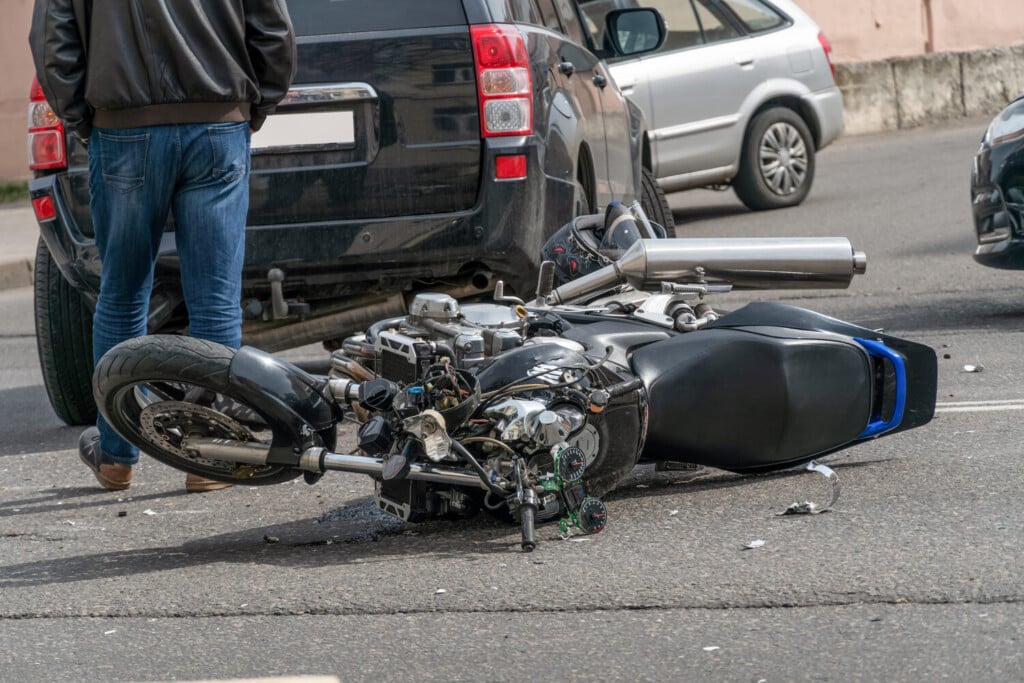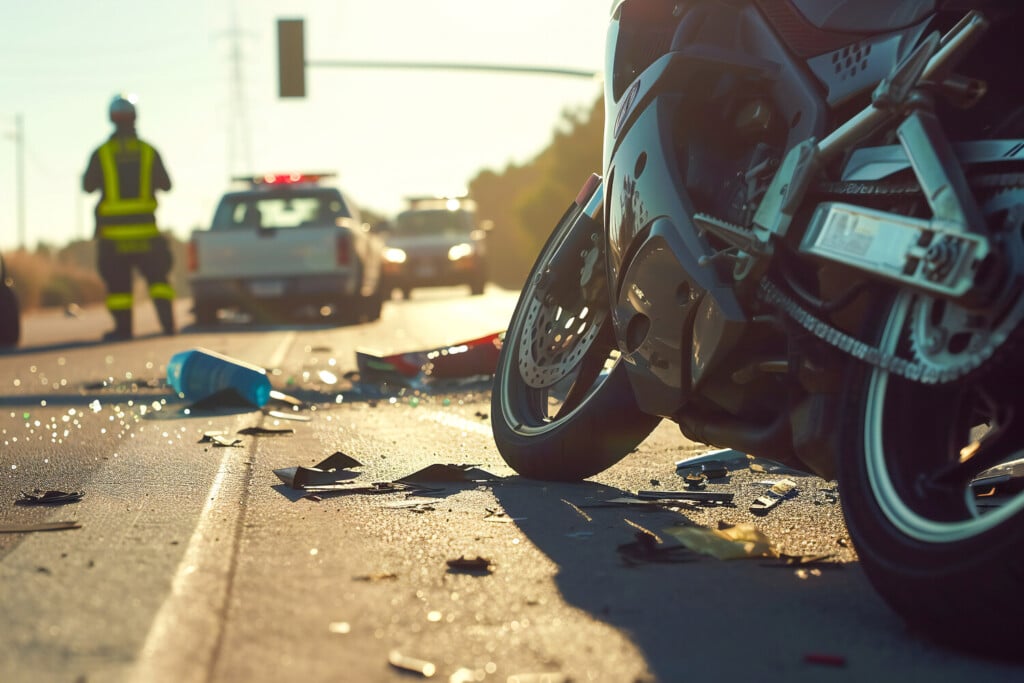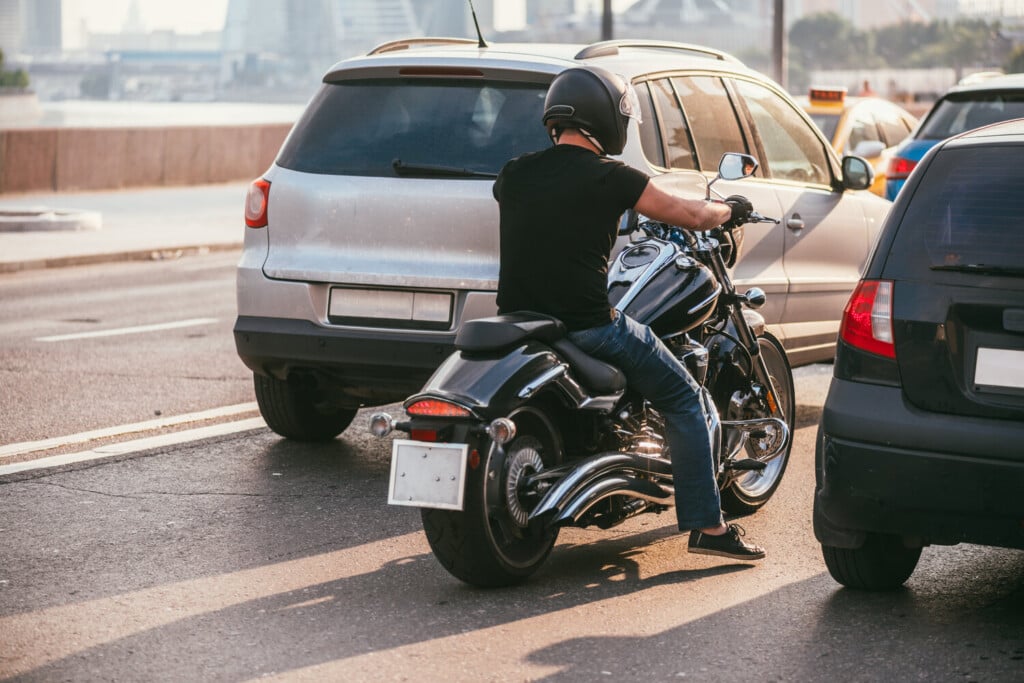RECENT POSTS
Categories
Who is at Fault in a Lane Splitting Accident: State Laws, Variables, & More
Riding around on a motorcycle can be a really fun time, but when accidents happen, the legal cases can get messy. We’re here to help walk you through the process of accidents, liabilities, and how to move forward.
When it comes to lane splitting accidents, the motorcyclist is often found at fault. That’s because lane splitting, riding between lanes of traffic, is illegal or discouraged in most states. It’s often viewed as reckless or unsafe behavior, making it difficult for motorcyclists to claim they weren’t at least partially responsible in the event of a crash. However, fault can still depend on the specific circumstances and local laws.
What Is Lane Splitting?
Lane splitting is when a motorcyclist rides between two lanes of traffic moving in the same direction. This typically happens during traffic jams or heavy congestion. Instead of staying behind slow or stopped vehicles, the rider weaves through the space between them, often riding along the lane divider or the white line.
Supporters of lane splitting argue that it helps reduce traffic, cuts down on commute times, and lowers the chance of being rear-ended in stop-and-go situations. However, many drivers, and traffic laws, view it as dangerous. The close quarters and unpredictable driver behavior make it risky, and in most states, it’s either illegal or not clearly allowed.
What Is Lane Filtering?
Lane filtering is similar to lane splitting, but it usually happens when traffic is completely stopped. For example, at a red light or in a gridlock. Instead of waiting in line with cars, motorcyclists slowly ride between them to reach the front.
Filtering is generally seen as a safer and more controlled maneuver than lane splitting because vehicles are not moving. Some states have started to legalize or pilot lane filtering laws, especially where traffic congestion is common.
Like lane splitting, the safety and legality of lane filtering depends on local laws. In states that don’t recognize it, riders may still be held at fault in an accident even if traffic was stopped.

Where Is Lane Splitting or Lane Filtering Legal?
California is the only state where lane splitting is fully legal. Motorcyclists are allowed to ride between lanes of traffic, and the California Highway Patrol even provides safety tips to help riders and drivers share the road. It’s been legal there for years, and riders are expected to split responsibly, usually at lower speeds and in slower traffic.
Utah allows lane filtering, which is a bit more limited than California. Riders can filter between stopped vehicles on roads with a speed limit of 45 mph or less, as long as they travel at 15 mph or less while doing it. This helps riders move to the front at stoplights or avoid being rear-ended in heavy traffic, but it’s not the same as lane splitting at highway speeds.
Montana also legalized lane filtering in 2021. Motorcyclists can filter between stopped or slow-moving traffic, but only when it can be done safely. The law gives riders more flexibility in congested situations, but like in Utah, it doesn't permit full-speed lane splitting.
Arizona joined the list in 2022 with a filtering law similar to Utah’s. Motorcyclists may filter between stopped cars on roads with speed limits under 45 mph, and again, they must stay under 15 mph while doing so. Lane splitting through moving traffic is still not legal in Arizona.
Colorado passed a new law in 2024 allowing lane filtering, but it’s very limited. Riders can only filter between cars stopped at red lights, and only if they’re traveling 15 mph or less. It’s meant to help reduce congestion and increase safety at intersections.
Minnesota, starting on July 1, 2025 will allow both lane splitting and lane filtering, but under strict rules. Riders can split or filter only on roads with at least two lanes going in the same direction, and they must ride below 25 mph and no more than 15 mph faster than surrounding traffic. The law also bans these practices in school zones, roundabouts, freeway ramps, and certain construction areas. Drivers are legally prohibited from intentionally blocking or endangering motorcyclists who are splitting or filtering.
Illegal or Unclear in Other States
In every other state, lane splitting and lane filtering are either explicitly illegal or not mentioned in traffic laws. If a rider tries these maneuvers in one of those states, they may be pulled over, ticketed, or found at fault if an accident happens. Regardless of whether they were being cautious.

Who is at Fault in a Lane Splitting Accident
In most cases, the motorcyclist is found at fault in a lane splitting accident. Especially in states where lane splitting is illegal or not clearly allowed. Since the rider is moving between lanes in a way many traffic laws don’t permit, it’s often seen as a reckless or unsafe maneuver. That makes it difficult for a motorcyclist to prove they weren’t at least partially responsible if a crash occurs.
Even in states where lane filtering is legal (like Utah, Arizona, or soon Minnesota), fault can still fall on the rider if they were speeding, weaving unpredictably, or filtering in areas where it’s not allowed (like school zones or single-lane roads).
But, fault is not always automatic. If a driver suddenly changes lanes without signaling or intentionally blocks a motorcycle, they may share responsibility or even be fully at fault, depending on the circumstances. As with any accident, the details matter and things like dash cam footage, witness statements, and local traffic laws can all affect the outcome.
How Negligence Affects Lane Splitting Accident Compensation
States commonly use contributory or comparative negligence systems to determine fault and compensation in personal injury claims. In lane splitting cases, these rules can significantly impact what the motorcyclist can recover.
Contributory Negligence States
In a few states, like Alabama, if the motorcyclist is found even 1% at fault, they may be barred from receiving any compensation. That means if the rider was lane splitting they could be denied recovery if the court sees that behavior as a contributing factor in the crash.
Comparative Negligence States
Most states follow a comparative negligence model, where fault is shared between both parties. In these cases, the motorcyclist may still recover damages but the amount is reduced based on their percentage of fault.
For example, if a court finds the motorcyclist 40% responsible for the accident, they may still recover 60% of their damages. This can apply even when lane splitting is technically illegal, depending on the other driver’s actions.
When the Other Driver May Be at Fault
While motorcyclists are often blamed in these accidents, drivers can also be found partially or fully at fault, especially when their actions directly lead to a crash. Common examples include:
- Abruptly changing lanes without signaling, cutting off a motorcyclist.
- Drifting between lanes in stop-and-go traffic.
- Intentionally blocking or swerving toward a lane-splitting motorcyclist.
- Opening a car door without checking mirrors or blind spots.
In these scenarios, a motorcyclist may be able to argue that the other driver’s negligence was the primary cause of the crash, even if they were lane splitting at the time.

When to Consider a Motorcycle Accident Attorney
Not every motorcycle accident requires a lawyer, but in many cases, having an experienced attorney can make a significant difference especially when serious injuries are involved or fault is disputed.
Here are key situations where you should strongly consider hiring a motorcycle accident attorney:
You Were Injured in the Crash
If you suffered serious injuries such as broken bones, head trauma, or anything requiring hospitalization or long-term care an attorney can help you pursue compensation for medical bills, lost wages, and pain and suffering. Insurance companies often offer lowball settlements in these situations. A motorcycle accident lawyer ensures your claim reflects the full extent of your damages.
The Other Driver Is Blaming You
Motorcyclists are often unfairly blamed in crashes, especially when lane splitting or filtering is involved. If there’s a question about who caused the accident, a lawyer can gather evidence, interview witnesses, and build a strong case to protect your rights.
Lane Splitting or Filtering Was Involved
If you were lane splitting or filtering regardless of whether it’s legal in your state you may face added legal challenges. An attorney like Wettermark Kieth that’s familiar with motorcycle laws can help argue for comparative fault, push back against bias, and navigate local regulations that might affect your case.
The Insurance Company Is Delaying or Denying Your Claim
Insurance companies sometimes stall, deny valid claims, or try to settle quickly for far less than you're owed. A lawyer can step in to handle negotiations, communicate with adjusters, and take the case to court if needed.
The Accident Involved a Hit-and-Run or Uninsured Driver
If the at-fault driver fled the scene or doesn’t have insurance, recovering compensation becomes more complex. An attorney can help you explore all available options, including uninsured motorist coverage and third-party claims.
Securing Compensation After a Lane Splitting Accident
If you find yourself in any of these situations and you need an attorney, reach out to us! Our team of personal injury lawyers at Wettermark Keith has decades of experience and is ready to take on your case. We’ll ensure that you get the justice and compensation you deserve.
Ready to work together? Contact us today for a free consultation.
HERE'S WHAT TO DO NEXT
If you or a loved one have been injured and think you might have a case, call us now for a free consultation.

